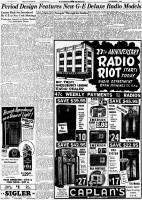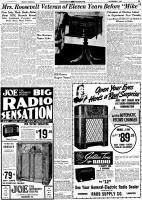|
<Previous
Next>
 Hello. My name is Kirt, and I'm a vintage
magazine and newspaper addict. This affliction has had a hold on me for two decades
now. Call it my middle age crisis. At sixty years old, there is no sign of abatement
in enthusiasm. Nearly every day I still find myself reading and commenting on articles
and advertisements from mid-last-century magazines, newspapers, and catalogs. Maybe
I'm hopeless and will never be able to kick the habit. I'm not alone, though, based
on some of the feedback received from RF Cafe visitors. For that reason and others,
maybe, in truth, I've grown comfortable with my addiction. Hello. My name is Kirt, and I'm a vintage
magazine and newspaper addict. This affliction has had a hold on me for two decades
now. Call it my middle age crisis. At sixty years old, there is no sign of abatement
in enthusiasm. Nearly every day I still find myself reading and commenting on articles
and advertisements from mid-last-century magazines, newspapers, and catalogs. Maybe
I'm hopeless and will never be able to kick the habit. I'm not alone, though, based
on some of the feedback received from RF Cafe visitors. For that reason and others,
maybe, in truth, I've grown comfortable with my addiction.
While perusing a few vintage newspaper editions from the World War II era
looking for relevant stories, I ran across this November 1, 1940 (exactly 78 years
ago) special section in the Harrisburg Telegraph titled, "Radio Industry
Marks 20th Anniversary." It contains many stories reporting on various aspects of
the first twenty years of the commercial radio market. Sure, radios were available
for sale prior to 1920, but the first commercial radio broadcast was aired by
KDKA in Pittsburgh,
Pennsylvania on November 2, 1920 (see tomorrow's RF Cafe webpage
day in history banner).
All of the pages have been posted here for your historical satisfaction. Excerpts
from a few of them have been OCR'ed and posted below. Click on the headlines for
large, legible versions of the pages with full stories.
Sets Combine New Advances In Reception (p17)
1941 Models Acclaimed Finest . in Broadcast History
With regular radio broadcasting service ready to celebrate the twentieth anniversary
of its inauguration, manufacturers, engineers and designers have combined in the
1941 sets to give the public a finer collection of radio models than ever before.
Not only have the standard receivers been refined in operation, but numerous
models are now being sold with provision for both television and frequency modulation
- those two new developments of radio that are hardly out of their swaddling clothes
but nevertheless ready for action.
Still another feature offered in new models is the increasingly popular radio-phonograph
- which several of the manufacturers are now equipping with apparatus for making
home recordings of both radio and the buyer's own programs.
Advances have been made, too, in the technique of broadcasting. The European
war has brought into being daily programs from overseas where only a few years ago
a broadcast from Europe was a thing marveled at. Actual on the field descriptions
of battles, on the ground and in the air, have been broadcast ...
'Hams' Form National Link To Bulwark U. S. Defense (p17)
Army of 60,000 Amateur Radio Operators Ready to Serve
Amateur radio has been preparing for 15 years to aid in national defense, by
developing techniques as well as provide apparatus, and to train competent operators,
it is pointed by Clinton B. DeSoto, assistant to the secretary of the American Radio
Relay League.
This training has been accomplished on a voluntary basis, without compensation
or compulsion of any kind, he explains.
Moreover, it has been accomplished by the use of equipment made or purchased
by the individual himself. There have been no governmental subsidies no handouts
by Uncle Sam. Our status throughout has been that of amateurs. We have paid our
way ...
New RCA Models Get Best Reception In Firm's History
(p18)
New Models Force RCA Sales To New Peak Throughout U. S.
New Styling and "Hidden Qualities" Credited For Increases
Unprecedented public enthusiasm in every section of the country is greeting presentation
of the new RCA Victrolas according to RCA Victor executives just returned from a
country wide tour.
"Never before in RCA Victor history has such an enthusiastic reception greeted
the new models in every section," declared Fred D. Wilson, sales manager in charge
of field activities. Mr. Wilson attended presentations in the Middle West.
"The emphasis which has been placed on tone quality, styling and overall performance
in the new instruments has been quickly recognized. We expect this to be one of
the best years we have ever had ..."
Sears Reports Big Up-Surge in Radio Sales (p18)
New Refinements and Features Credited For Increases
An amazing public acceptance has greeted the 1941 line of Silvertone radios from
Maine to Texas, according to officials of Sears, Roebuck and Company.
One reason advanced for the unusual pick-up in sale lies in the fact that the
new line marks an all time high in stunning style new wrinkles and sensationally
low prices. Silvertone radios for 1941 offer a set for every one, from the modest
table model at $6.95 that can be held comfortable in one hand, to the aristocratic
Model R-121 that sports 12 tubes and matchless performance in an amazing beautiful
cabinet ...
New Features Predominate 1941 Line of Crosley Radios
(p19)
Richness of Tone Coupled With Appearance Included in Models
The 1941 twentieth anniversary Crosley glamor-tone radios, radio-phonograph combinations
and home recording sets, recently announced by the Crosley Corporation, include
many new features that make the outstanding in performance as well as appearance.
Most sensational is the new richness and fidelity of tone that has been developed
in these radios, which the Crosley Corporation adopted the name glamor-tone to describe.
"Crosley glamor-tone," said W.T. Wallace, manager, radio division, the Crosley
Corporation, "is the result of 20 years of intensive radio experience and research,
dating back to the period of radio when rapt listeners first masters the knack of
manipulating a crystal set. With glamor-tone, Crosley achieves a fidelity of reproduction,
together with super-sensitivity and selectivity, that represents a new high in radio
reception ..."
Period Design Features New G-E Deluxe Radio Models
(p21)
Custom Made Sets Introduced By G-E at New York Showings
Production Started on Deluxe Models For Individual Tastes
Combining the experienced efforts of craftsmen in fine furniture and modern radio-phonograph
engineering, a new series of deluxe instruments bearing the name "Musaphonic" has
been created by General Electric Company, Bridgeport, Connecticut.
The first three models of the series, a small table cabinet and two console types,
were introduced to invited groups of decorators, dealers, and general magazine and
trade editors at special showings recently in New York City. The instruments are
to be displayed and demonstrated in various parts of the country as samples become
available ...
Light Beam Device Hailed Modern Marvel (p21)
Experts Lived With Devices To Perfect 1941 Philco Sets
Engineers Started With Five Objectives to Be Overcome, Grimes Says
Thomas Edison once remarked that if anything had gone for a number of years without
improvement, it was time to do something about it.
Philco took this as their text when it became apparent that the revived interest
in recorded music demanded that "something be done about the phonograph" in view
of the total absence of any basic improvements in the machine since its invention
by Edison, according to David Grimes, Philco chief engineer.
Consequently, the research department started "living with phonographs." A critical
attitude was taken in approaching the problem and after the most exacting test of
both Philco and other makes of phonographs, it was decided to attempt a completely
fresh start ...
Posted November 1, 2018
|








 "
"






